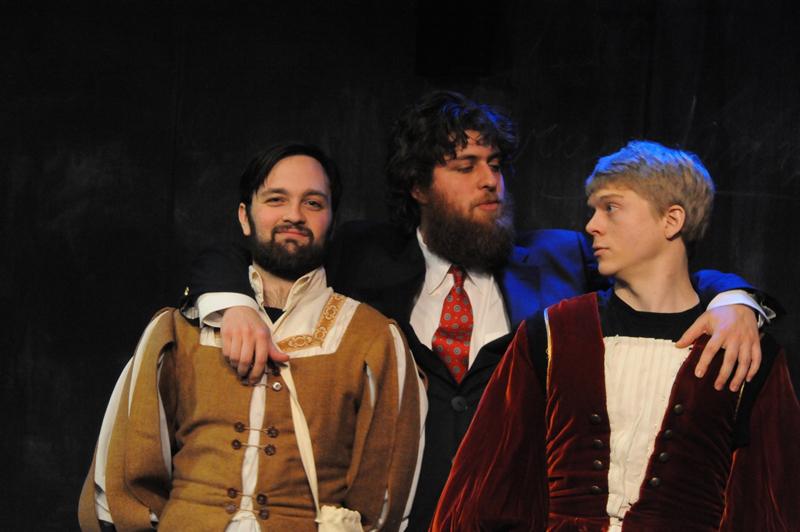When Hamlet Meets the Absurd: Oberlin Theater Does ‘Rosencrantz and Guildenstern Are Dead’
(From left) College seniors Zach Weinberg as Rosencrantz, Joshua Selesnick as Claudius, and Colin Wulff as Guildenstern deliver a gripping performance in the Little Theater. The performers in Rosencrantz and Guildenstern Are Dead rehearsed during Winter Term to present a play that combined Shakespearean tragedy with absurdist comedy.
February 7, 2014
Shakespeare is an immensely popular playwright, constantly performed by professionals and amateurs alike. His work is, by all accounts, a safe choice. But what happens when a playwright creates a situation of his own within one of Shakespeare’s works? Rosencrantz and Guildenstern Are Dead, written by absurdist playwright Tom Stoppard, is set in the world of Shakespeare’s Hamlet and does a phenomenal job of integrating modernist and absurdist ideas into one of the Bard’s most recognized works. Last Sunday through Thursday, audiences had a chance to witness the players of Oberlin’s Theater and Dance Program provide their own interpretation of the metatheatrical work in the Little Theater.
The focus of the play and its namesakes are Rosencrantz and Guildenstern, two minor characters in Hamlet who meet their untimely end attempting to deliver Hamlet to the King of England. The two are foils of each other; where Rosencrantz is childish, Guildenstern is logical. In spite of their differences, they are best friends. The pair is constantly lost, both figuratively and literally. The rules of logic, on which they have counted in the past, have abandoned them, stranding them in a world where actors’ fake deaths are more believable than the real thing and their childhood friend, Hamlet, has gone mad.
In the performance, this central pairing was a high point of the show — the title characters were simply a delight to watch. College senior Zach Weinberg, who played Rosencrantz, skillfully presented a fleshed-out character. Underneath Rosencrantz’s silly and quasi-idiotic façade, he is fearful and aware of his inability to control his fate. Weinberg transitioned seamlessly between these traits, keeping his voice chipper for witty lines and adopting a shockingly heavy timbre for those that merited more emotion.
College senior Colin Wulff’s portrayal of Guildenstern was similarly fitting. For most of the play, Wulff held his head high and maintained a slight smirk that exemplified Guildenstern’s droll, logical side, but in the penultimate scene, he and his partner delivered a haunting dialogue. Wulff’s words were strong, yet his shaking voice underscored Rosencrantz’s fear of what lay before them. College senior Sarah Rosengarten, who both directed the production and performed the role of the Player, was equally impressive. She showcased her deep connection to her art as well as her character’s fun side, attempting to persuade Rosencrantz and Guildenstern to “participate” in her troupe’s sexually charged production for a fee. The decision to make the Player a woman further distanced the title characters and the actors, contributing to the image of the Player as a ringmaster of sorts — and the actress doubling as a director adds a fascinating layer of metatheater.
Of all the effects employed in this production, the most impressive was a chalkboard on which Rosencrantz, Guildenstern and the Tragedians — the aforementioned theater troupe — wrote. This chalkboard served as the entirety of the set as both a constantly changing backdrop to the action of the play itself and the embodiment of Rosencrantz and Guildenstern’s disorientatio. At times, it was a scoreboard; at others, it became a banner; and sometimes, it was just used for doodling. The characters were somewhere, yet nowhere, floating in a world of ideas. College senior Aaron Palmer, the play’s lighting designer, capitalized well on the darkness of the Little Theater. The last few scenes — unsurprisingly, the most dramatic and philosophical — were immersed in almost total darkness. In these moments, the characters were truly alone, floundering in the unknown, symbolized dramatically by the literal lack of light.
The only aspect somewhat lacking in this production of Rosencrantz and Guildenstern Are Dead was, in fact, the central conceit of the play — that the title characters were those from Shakespeare’s play. To cement the connection between his own play and Hamlet, Stoppard samples excerpts of Shakespeare’s work within his own. The presence of these elements not only allows the audience to understand where the characters are in the scheme of Shakespeare’s play, but also convinces them that both stories are occurring simultaneously — in the same universe. Hamlet’s final monologue, delivered by Horatio (played by College sophomore Peter Elgee), had a quality and depth that embodied this relationship and was a fitting end to the adventure that was Rosencrantz and Guildenstern Are Dead. The rest of the production, however, didn’t achieve the end of connecting Stoppard’s script to Shakespeare’s. Actors recited lines from Hamlet in extremely affected tones that conveyed to the audience that the Hamlet characters didn’t exist in the same world as Rosencrantz and Guildenstern. The two plays are necessarily connected and should have been portrayed as such, but this adaptation inappropriately and unfortunately distanced them.





















